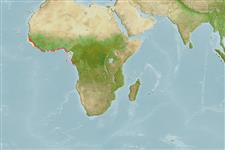Elasmobranchii (sharks and rays) >
Rhinopristiformes (Shovelnose rays) >
Rhinidae (Wedgefishes)
Etymology: Rhynchobatus: Greek, rhingchos = snout + Greek, batis, -idos = a sting ray (Raja sp.) (Ref. 45335).
Eponymy: Hans Julius Lübbert (1870–1951) studied politics and law at universities in Kiel and Rome, but caught severe malaria and had to change course. [...] (Ref. 128868), visit book page.
Environment: milieu / climate zone / depth range / distribution range
Ecology
Marine; demersal; depth range 0 - 35 m (Ref. 106604), usually ? - 35 m (Ref. 27000). Tropical; 28°N - 5°S, 20°W - 10°E (Ref. 114953)
Eastern Atlantic: Congo to Mauritania.
Size / Weight / Age
Maturity: Lm ? range ? - ? cm
Max length : 300 cm TL male/unsexed; (Ref. 2683); common length : 150 cm TL male/unsexed; (Ref. 26999)
Benthic (Ref. 114953). Occurs in shallow coastal waters, more or less stationary. Ovoviviparous (Ref. 50449). Adults feed mainly on small bony fishes and invertebrates. Females have litters of 2-5 pups. Maturity size unknown but born at 79-85 cm TL (Ref. 114953).
Life cycle and mating behavior
Maturity | Reproduction | Spawning | Eggs | Fecundity | Larvae
Exhibit ovoviparity (aplacental viviparity), with embryos feeding initially on yolk, then receiving additional nourishment from the mother by indirect absorption of uterine fluid enriched with mucus, fat or protein through specialised structures (Ref. 50449).
Reiner, F., 1996. Catálogo dos peixes do arquipélago de Cabo Verde. Publ. Avuls. Inst. Port. Invest. Mar. 2:339 p. (Ref. 27000)
IUCN Red List Status (Ref. 130435: Version 2024-1)
Threat to humans
Harmless
Human uses
Fisheries: commercial
Tools
Special reports
Download XML
Internet sources
Estimates based on models
Preferred temperature (Ref.
123201): 23.2 - 28, mean 26.5 °C (based on 100 cells).
Phylogenetic diversity index (Ref.
82804): PD
50 = 0.5049 [Uniqueness, from 0.5 = low to 2.0 = high].
Bayesian length-weight: a=0.00372 (0.00163 - 0.00845), b=3.11 (2.91 - 3.31), in cm total length, based on LWR estimates for this (Sub)family-body shape (Ref.
93245).
Trophic level (Ref.
69278): 4.5 ±0.80 se; based on food items.
Resilience (Ref.
120179): Low, minimum population doubling time 4.5 - 14 years (Fec assumed to be <100).
Fishing Vulnerability (Ref.
59153): Very high vulnerability (90 of 100).
